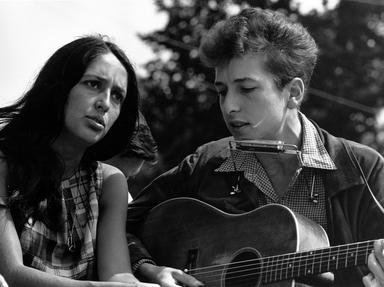Quiz Answer Key and Fun Facts
1. Can you guess the name of this famous Bob Dylan song?
'The speleologist pines for his place of birth' (1965)
2. What's the correct name of this epic 60s Bob Dylan song, which filled an entire LP side of a double album?
'Melancholy mistress of the Mississippi mudflats' (1966)
3. What is the name of this late 60s Bob Dylan song famously covered by Jimi Hendrix?
'For the full breadth of the battlements' (1968)
4. This Bob Dylan chart-topper was covered by the persons mentioned in the hint 30 years later. What is it?
'In a similar fashion to Mick, Keith et al.' (1965)
5. What's the title of this vitriolic Bob Dylan album track said to express his contempt for the British press?
'A slow narrative about a malnourished male' (1965)
6. What's the name of this contemptuous Bob Dylan 'anti-love song' from the mid-60s?
'It's the next set of lights after three, no question about it, driver' (1966)
7. This 60s Bob Dylan song was a hit for Cher and the Byrds, among others. Can you identify it?
'In a nutshell, it's the sum total of my intended action, honestly' (1965)
8. Bob Dylan surprised his fans by trading in his characteristically caustic carping for a romantic croon with this late 60s album track. Can you identify it from the hint?
'Your street-fashion collection? Oh, sorry. I left it out for the trashman.' (1969)
9. Can you work out the name of this lighter-themed 1960s Bob Dylan song about just wanting to be somewhere else?
'Pastures in the possession of the UK's late "Iron Lady", perhaps?' (1966)
10. This Bob Dylan song was also the title of one of his most influential albums. Can you name it? (Be careful - the hint is 'in other words', not song lyrics)
'The Mississippi River is shining like a National guitar' (1966)
11. Which Bob Dylan song matches this famous line from 1993's acclaimed Robert De Niro/Chazz Palmieri collaboration 'A Bronx Tale'?
'Now youse can't leave!' (1967)
12. Can you identify this classic Bob Dylan song from his early 60s 'protest' years?
'It'll come down calcified cats and difficult dogs any time now' (1963)
13. Can you name this epic Bob Dylan album track?
'I dream of Heidi' (1966)
14. Can you identify the widely covered bittersweet song of parting by Bob Dylan from the clue below?
'No need to reconsider your position. I've already accepted it as is.' (1963)
15. Can you identify this mid-60s Bob Dylan classic?
'Mrs Doubtfire', or 'Tootsie', perhaps?' (1966)
Source: Author
lifeliver
This quiz was reviewed by FunTrivia editor
agony before going online.
Any errors found in FunTrivia content are routinely corrected through our feedback system.
